Bad communication habits can sink your organization.
You might think that, as long as everyone’s doing their job, your company will keep floating in the uneasy waters of an inflation-ridden economy.
However, the truth is that with ineffective communication, your organization is at great risk of crumbling under the pressure of a competitive market.
Since communication is a social activity that everyone participates in, you must ensure every member of your organization is doing their part. And that means eradicating bad communication habits.
Keep reading to see which bad communication habits are endangering your success and how to break them.

Bad communication habits that hinder your growth
A 2022 study on the effects of poor communication in the Global Science Research Journals shows that poor communication in a company leads to:
- Lack of team cohesion and trust,
- Wasted time and resources,
- Low employee morale and engagement,
- High turnover rates, and
- Loss of revenue.
To ensure that doesn’t happen to you, your team, or your company, you need to correctly identify the examples of negative communication and work on breaking them.
Here are the top 8 bad communication habits that are probably eroding your success as you’re reading this. But don’t worry — all examples of bad communication will be closely followed by a solution that will help you foster effective communication in yourself and with others.
#1 Minimal communication or lack of communication
Imagine you’re working in a company that has zero communication regulations and, on top of that, you have an uncommunicative manager.
For example, you might message him over your team communication app to report on your progress and ask some questions (such as whether something was to be done one way or the other), and receive an “OK” as a reply.
Here’s an example of that shown on Pumble, a business messaging app.
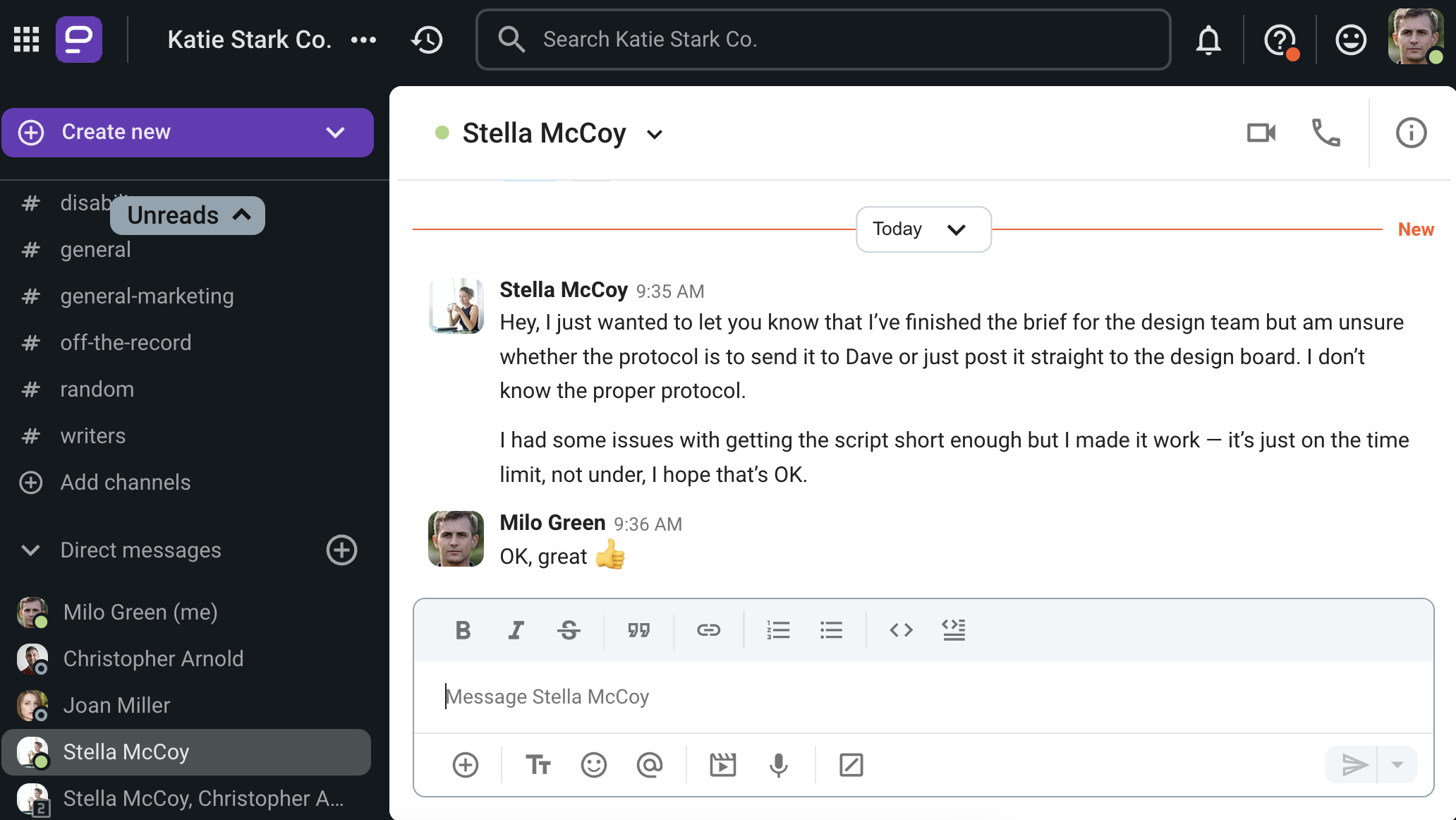
At first glance, it might seem like communication has taken place — after all, your manager noted and seemingly approved of your progress. But, in reality, you didn’t get any information and you’re left guessing what you should do next.
The main issue with lack of communication is that it breeds assumptions, as Kimberly Best, Dispute Resolution Expert & Founder, mentioned:

“Minimal communication often involves assumptions. In the absence of information, we are hard-wired to make up our own stories. These are things like, ‘If I tell her, she’ll be mad’, or ‘She already knows,’ and ‘Someone else will do it’ — things like that. The problem is, these stories are rarely true.”
💡 Pumble Pro Tip
If you’re wondering whether communication in an organization is important or not (spoiler alert: it is), you should read the resource guide below:
Enhance your team communication with Pumble
How to break the habit of minimal communication
You’ll probably find this an obvious answer, but the only way to combat a lack of communication is — with communication.
As Best testifies, breaking this habit is a necessity that starts with a simple act:

“The antidote is quite simple, yet takes a moment longer — ask. If we think of setting ourselves, our colleagues, and our organization up to ‘win’, we can see the need for collaboration and clear communication.”
Let’s take a look at how asking for clarification would alter the exchange from the previous example.
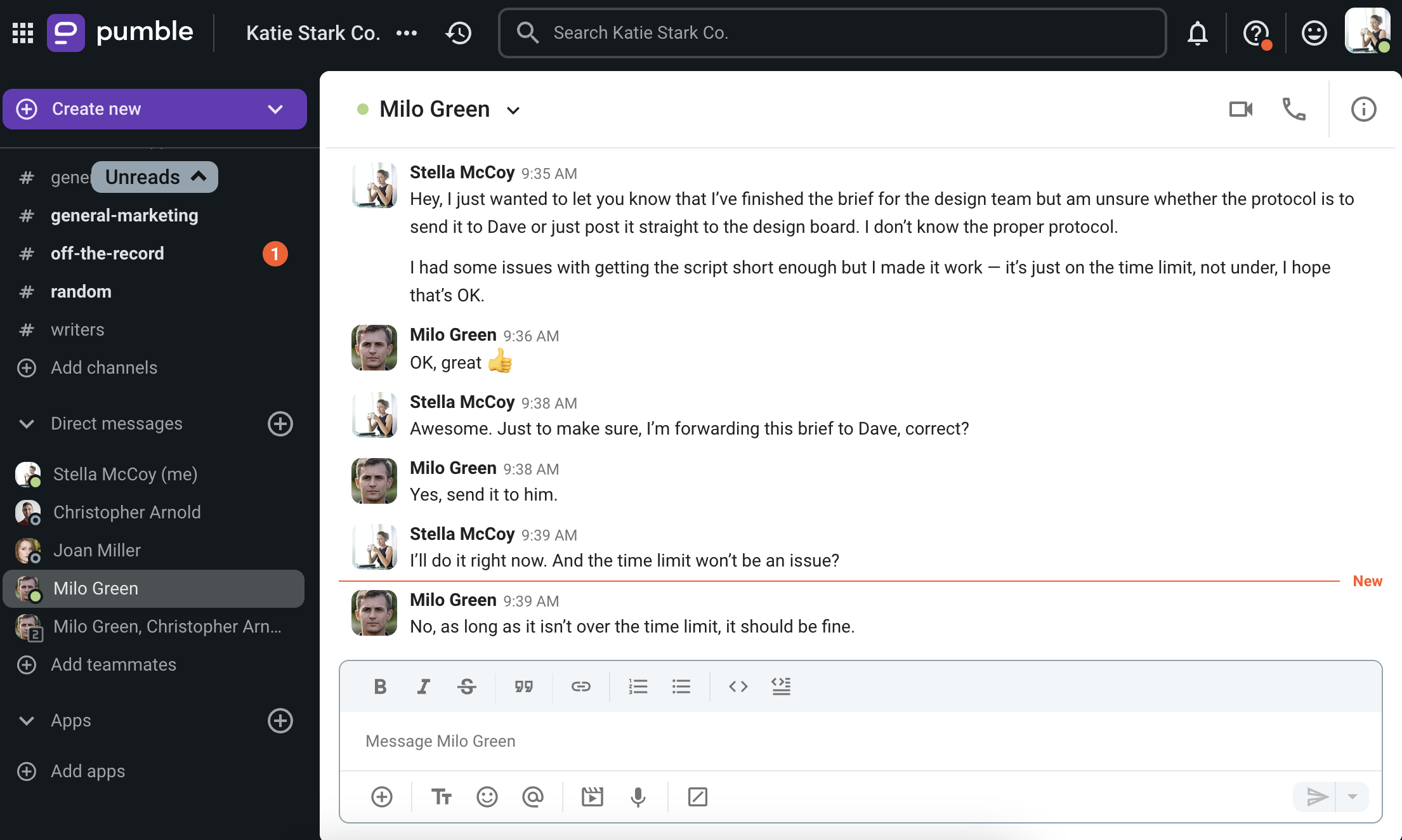
To ensure communication is actually taking place in your team, you also need to lead by example.
If you notice there’s a stark lack of communication in your team, you need to arrange different communication conditions. To be effective, communication needs to happen at high frequency and be highly visible.
To create an environment for that, you can utilize internal communication software like Pumble. There, you can set up a designated channel for each team or project where people will be able to exchange information, ideas, and solutions.
The best thing about this solution is that channels leave enough room for both professional and regular, candid communication that will ensure the team is connected and on the same page.
If, on the other hand, you notice that the problem is a lack of communication on your part, you can do the following:
- Stop presuming that something is “common sense” and, thus, doesn’t need to be communicated,
- Don’t assume someone understands you just because they aren’t asking follow-up questions, and
- Ask questions such as “Are you with me so far?” or “Do you understand?” to ensure your interlocutors understand you.
💡 Pumble Pro Tip
To get more tips on how to improve communication within your team, read the following Pumble guide:
#2: Lack of active listening
You may think your success in the workplace depends solely on you saying the right things (thus showing how much you know and can do).
However, being a good listener might be even more important — so important that the ability to listen and really hear what the other person is trying to say is regarded as one of the highest-valued skills of effective communicators.
You can be the best orator in the world, if your colleagues aren’t feeling heard by you when they talk to you, you’ll be labeled as a bad communicator.
And with good reason!
As Dr. Lilit Ayrapetyan, Psy.D., Licensed Clinical Psychologist, told us, lack of active listening is one of the bad communication habits with the worst consequences:

“It may seem like a small thing, but one of the worst communication habits to have when it comes to professional communication is not listening — and by listening, I mean truly, actively listening. When someone fails to really listen to their colleagues, it not only leads to misunderstandings and errors but can also create an environment where others feel undervalued and ignored.”
It’s quite easy to notice that someone isn’t actively listening to you.
Let’s take your noncommunicative manager from the previous chapter as an example.
If you were to ask him for clarification on a topic, he might:
- Appear to be distracted while you were asking him questions,
- Ignore your Pumble messages,
- Interrupt you while you are speaking, or even
- Start criticizing you.
Here’s an example of what that might look like.
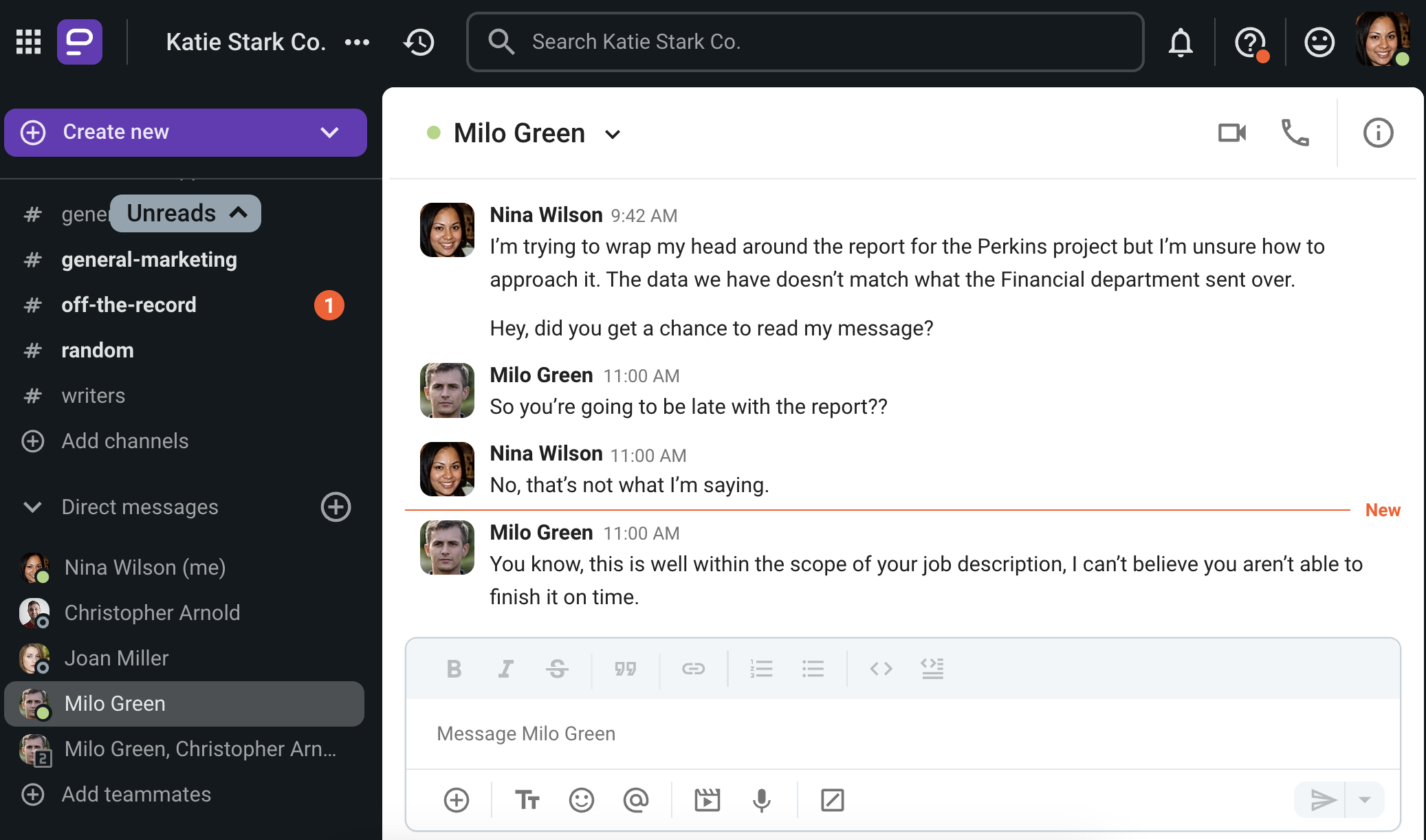
Poor listeners — like Milo in the example above — lack the crucial skills of effective communicators and aren’t listening to understand, as Dr. Ayrapetyan noted:

“Active listening involves more than just hearing words; it requires understanding, engaging, and responding appropriately, which helps:
- Build trust,
- Avoid confusion, and
- Improve clarity in professional relationships.”
How to break the habit of not listening
To break the cycle of poor listening and improve communication — while also enjoying the benefits Dr. Ayrapetyan mentioned — you need to ensure you’re respecting the 3 As of active listening:
- Attitude — having the right (positive) attitude allows you to better retain and understand the information presented to you;
- Attention — being fully focused on the speaker and paying attention to what they’re saying, their body language, and other nonverbal cues;
- Adjustment — following what the speaker is saying without making assumptions about the overall point.
Our contributor Best broke down what it means to be an active listener:

“Active listening is reflected in:
- Asking clarifying questions and checking to make sure that you do understand what the person is saying,
- Listening without trying to find fault, and
- Listening without judgment.
Active listening is crucial for understanding, building trust and relationships, and effective problem solving.”
Let’s take a look at an example of proper active listening in the workplace and see what Milo could have done differently.
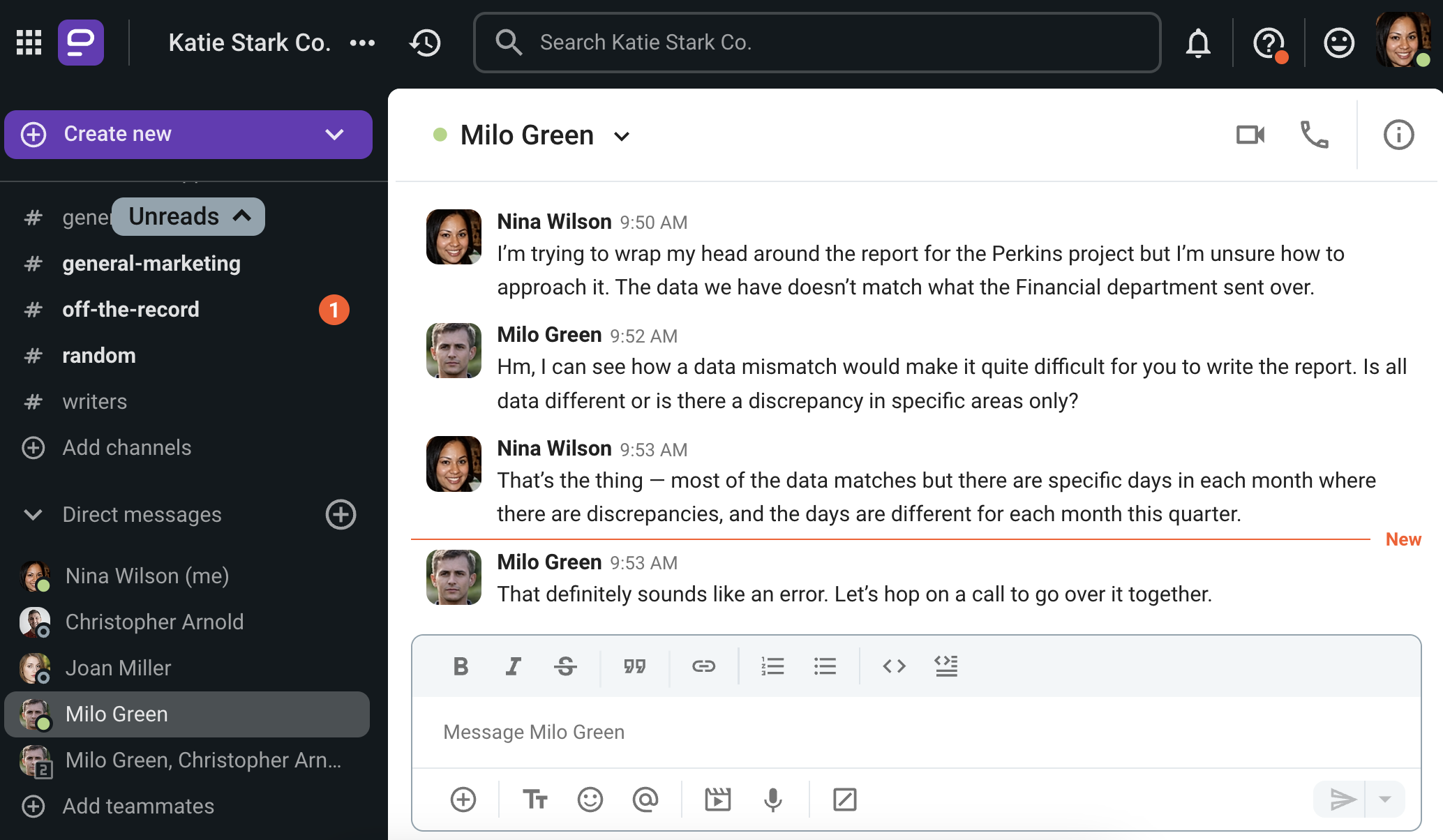
💡 Pumble Pro Tip
To find out more about active listening and its importance, read our full guide:
Practice effective communication skills in Pumble
#3: Not answering questions that are asked
When someone asks you how to do something, does your answer mostly revolve around the importance of the something they asked about? If so, then you’re suffering from the bad communication habit of not answering the questions that are asked.
Sometimes, we might unintentionally do this due to our eagerness to answer and share knowledge, which makes us jump the gun and answer before we listen to the question in its entirety.
Other times, we might resort to scripted answers — when we feel the question is out of our depth, for example. In those situations, we might be so focused on the script we forget to pay attention to the actual question.
In both cases, we end up sending an entirely wrong message, as Neil Thompson, Engineer, Technical Communication Expert, and Founder, mentioned:

“Answering questions that are not asked makes the other person think that we’re not listening to them or that they’re not worth listening to. Not the best way to ingratiate ourselves with decision-makers!”
Here’s what not answering questions that are asked might look like in the workplace.
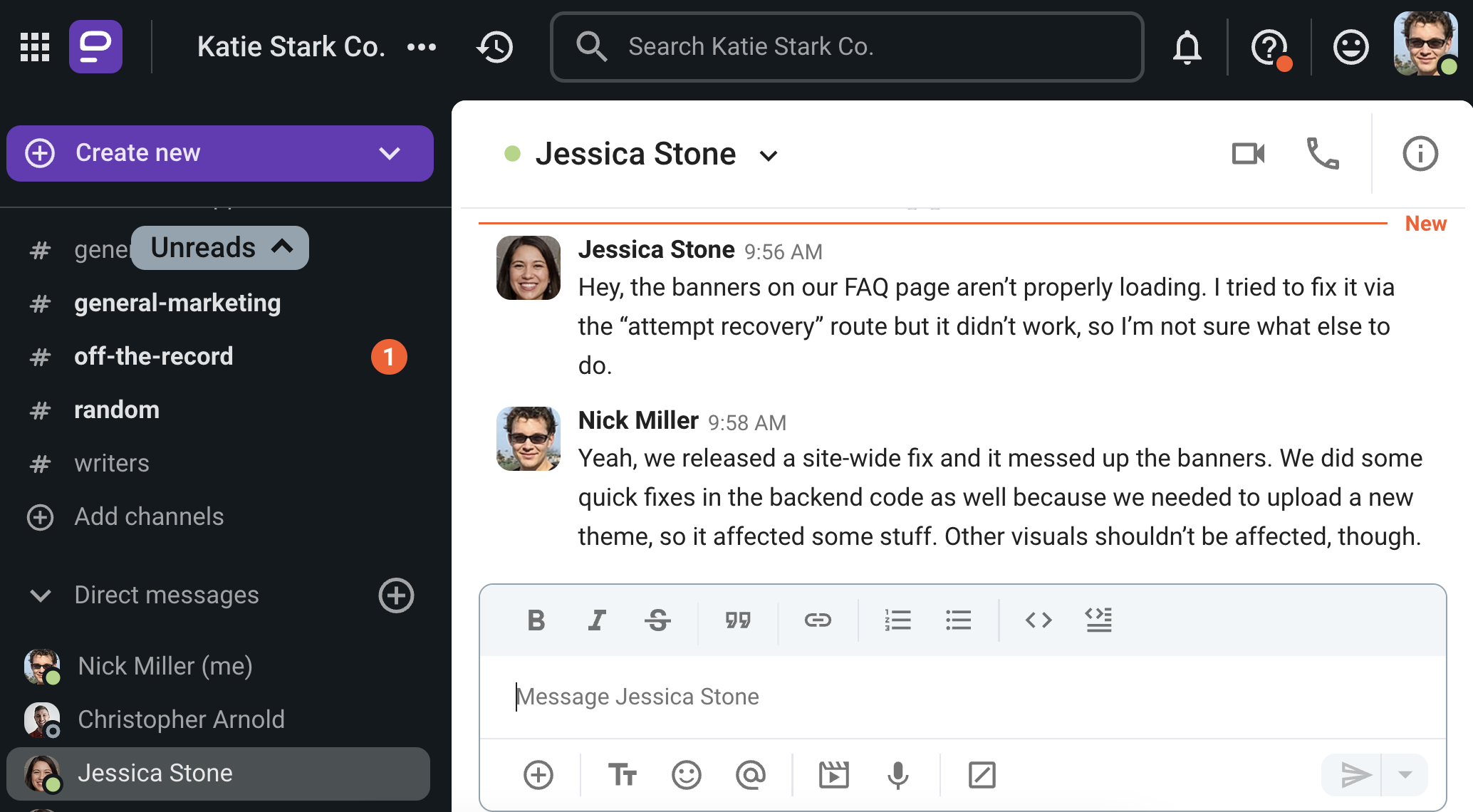
How to break the habit of not answering questions that are asked
Once again, the answer to your troubles is — listening. Or, better said, listening to understand, as Thompson noted:

“We need to do better at actively listening to the question. Restating the question back to the person who asked it to make sure we understand the question correctly works wonders.”
Here’s how the conversation from the previous example would have gone if Nick had listened to understand and answered the questions asked.
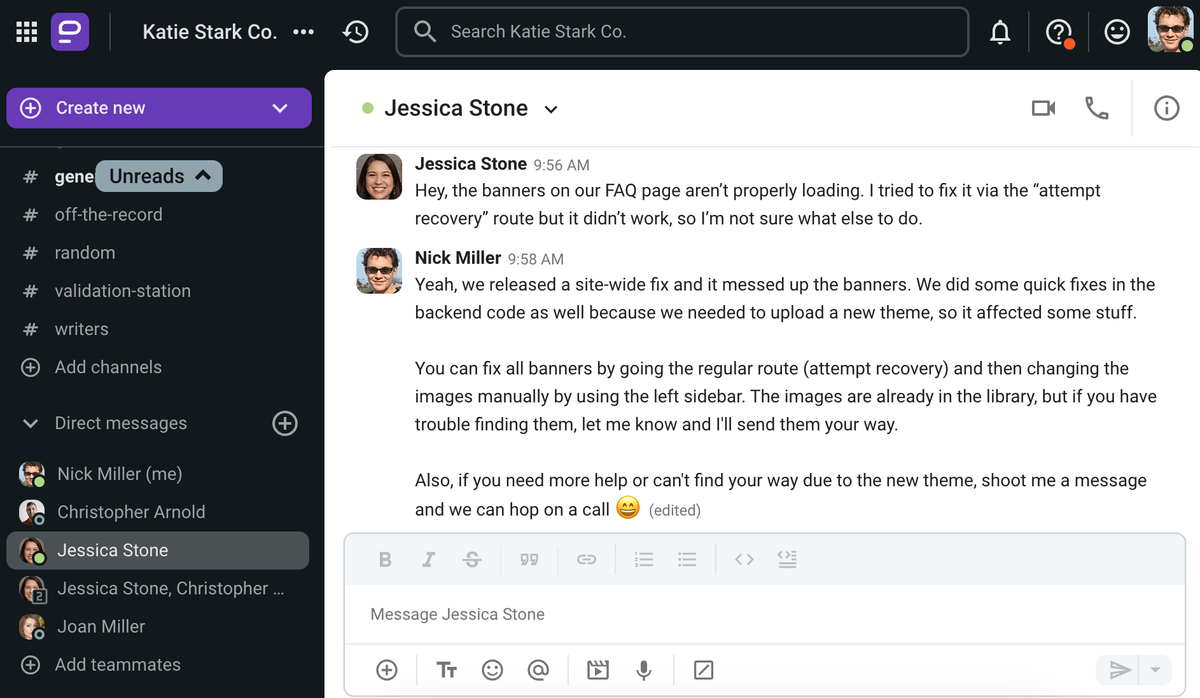
And, if you fall into the second category — where you don’t answer the questions asked due to your fear of being perceived as unknowledgeable — aside from listening, you should also consider a different tactic.
Namely, admitting that we don’t know something is a completely valid response. Contrary to popular belief, not knowing an answer to a question isn’t a sign of weakness.
However, it’s vital that we don’t stop there, as Thompson mentioned:

“Getting comfortable saying ‘I don’t know’ is important, too. The key is to not stay not knowing. Find the answer, especially when talking to decision-makers.”
💡 Pumble Pro Tip
Asking the right questions is crucial in the workplace and almost as hard as answering them. But how do you ask the ones you know are difficult? Read our blog to find out:
#4 Cutting people off
Interrupting others is one of the biggest communication issues in the US, according to a 2024 study on bad communication habits conducted by Preply. 24% of people report this as their most significant communication issue.
Other issues they reported — that stem from being interrupted — are being talked over (19%) and having to repeat themselves (18%).
Interrupting others when they’re talking demonstrates not only a lack of regard for the person who’s talking but also self-centeredness.
Now, in your day-to-day life, interrupting others might not be a big problem. In the workplace, however, it can have serious consequences, as Lucas Botzen, HR Expert and CEO noted:

“A fatal distractor to effective communication is talking over others in the middle of the conversation and failing to listen to them to completion. These habits establish a lack of respect and consideration for others, which could alienate your colleagues and decrease your professional reputation.”
No matter the reason you do it, interrupting others sends only one message, according to Kelly L. Campbell, Certified Trauma-Informed Leadership Coach and Author:

“It becomes clear that there is an egotistical need to be heard at the cost of devaluing others.”
How to break the habit of cutting people off
The first step to breaking this bad habit is to become aware of it and take responsibility.
As Campbell testifies, this is a crucial step that will snowball into a solution:

“Once a low-conscious leader takes responsibility for their maladaptive behavior through healing modalities, their communication style will improve because they will feel less compelled to center their own experience and will become more curious about others. This creates a more conscious approach to communicating in the workplace, which builds trust and collaboration — both of which are integral to organizational success.”
If you notice that your communication style involves a lot of interrupting on your part or that you dominate more conversations than not, then you should take a good, hard look at what you can change to improve your daily communication.
Taking responsibility isn’t easy, but it’s much better than monopolizing conversations in the workplace — as that can only come back to bite you in the behind.
💡 Pumble Pro Tip
Not every interruption is inherently bad — as long as you do it right. To find out how to politely interrupt your colleagues, check out this article:
#5 Invalidating or dismissing the perspectives of others
In an ideal world, we’d all be working in psychologically safe environments, where we feel free to express ourselves and our opinions and ideas.
However, many don’t feel this way because they work with people who have a tendency to invalidate or completely dismiss others’ perspectives.
Validation is vital in the workplace because it nurtures a positive work environment and makes us feel seen and heard. So, when we invalidate others, we make them feel undervalued and as if their opinions don’t matter. This can lead to people second-guessing themselves, which can impact their performance.
That’s exactly why Campbell highlighted this poor communication skill as the worst one to have in the workplace:

“The worst communication habit to have when it comes to professional communication is invalidating or dismissing the perspectives of others because it:
- Erodes trust,
- Disempowers others, and
- Creates unnecessary fear, anger, and/or resentment.”
How to break the habit of invalidating or dismissing others
You can break this bad communication habit in yourself and others by being proactive.
It’s important to note that this isn’t an issue that can be resolved quickly or in the heat of the moment. Instead, you should find a time when everyone is level-headed and introduce a calm discussion about what invalidation can do in the workplace and how your team can handle it.
For example, you can set up a dedicated Pumble channel where you can discuss this with your team and later use it to implement validating behavior. You can share individual and company-wide success stories there, to nurture a positive, encouraging environment in your team.
Take a look at the image below to see how that would look like in real life.
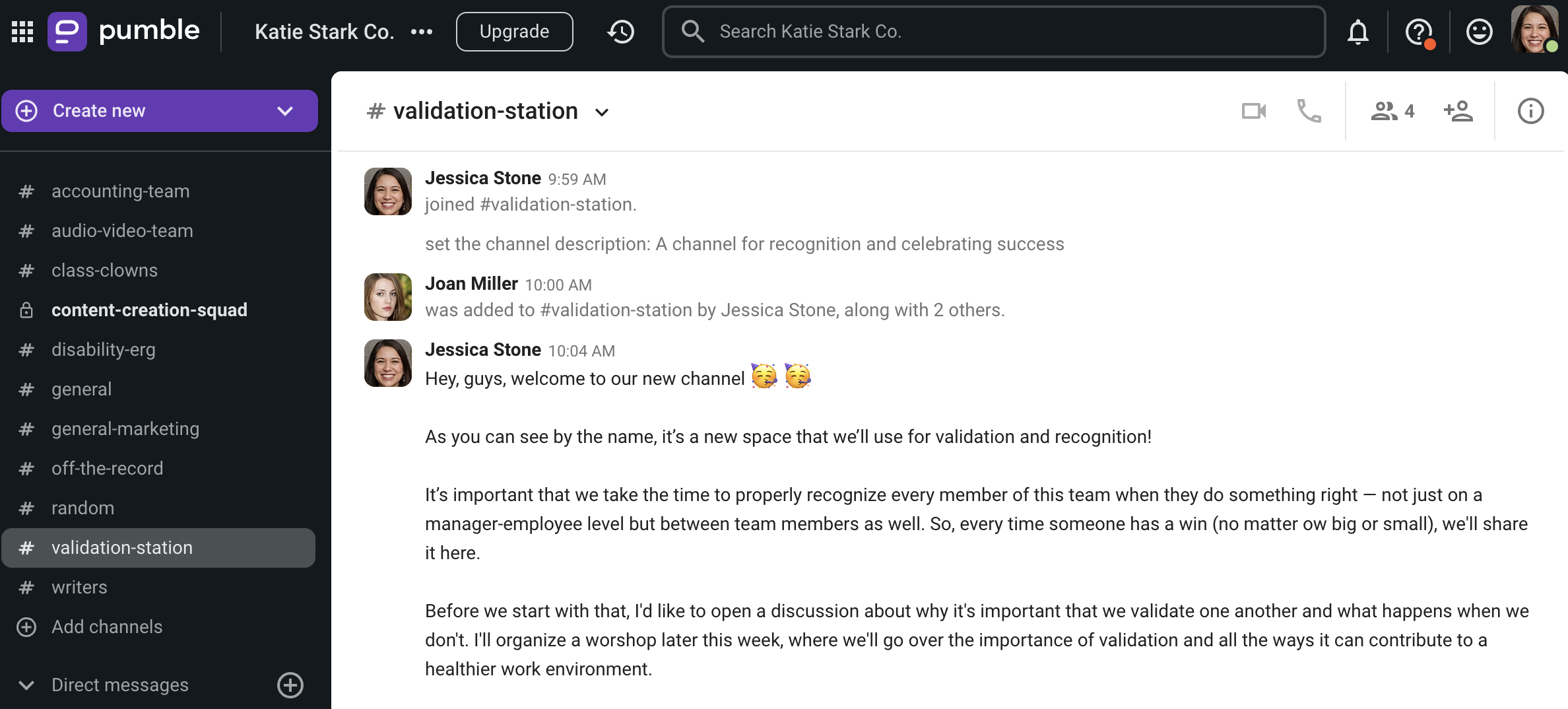
Pumble can also help you not forget about this — if validating others doesn’t come naturally to you, you can set up reminders for yourself to check in on others’ progress and recognize them for their hard work.
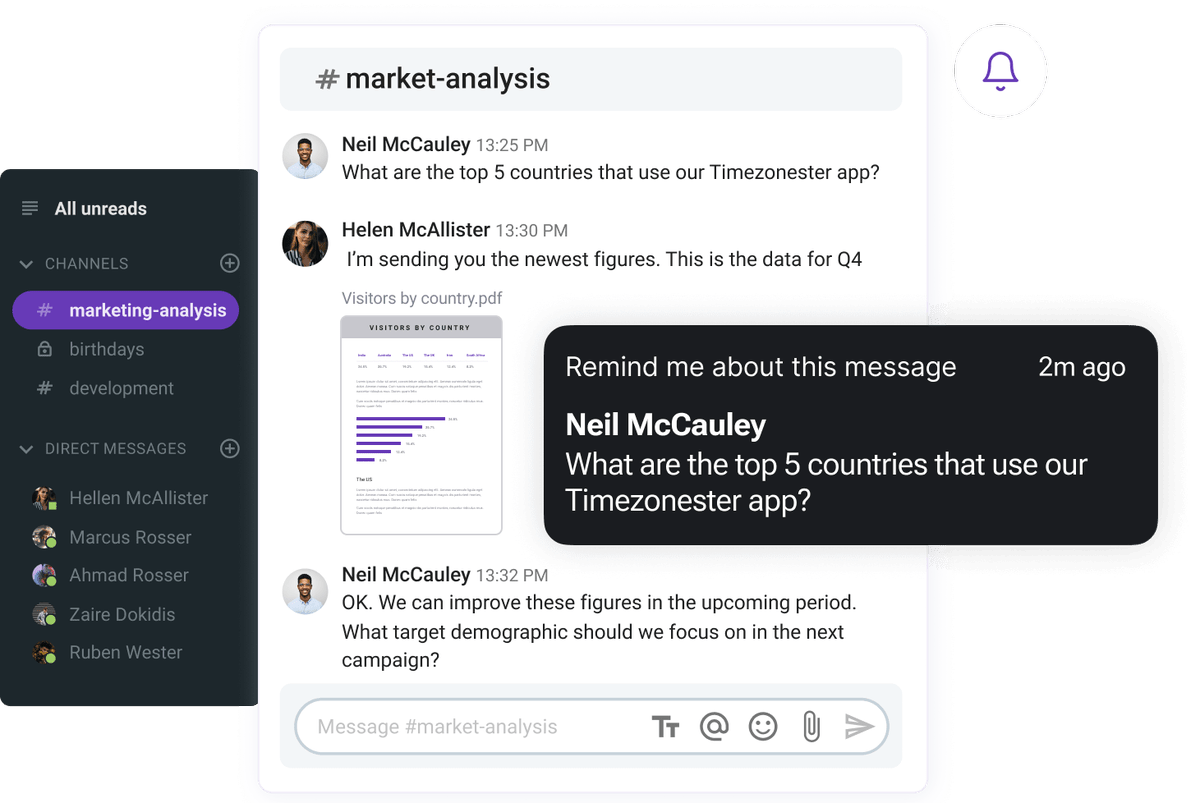
Never miss a chance to recognize your teams’ hard work with Pumble
#6 Responding (too) quickly
In our effort to not invalidate and dismiss others, we might inadvertently slip into another bad communication habit — responding too quickly.
Oftentimes, we tend to speak quickly and without pausing because we want to share as much information with our listeners as possible.
However, by doing this, we don’t leave others enough time to digest what we’re saying or properly react to it.
Aside from not being a particularly engaging behavior — since we’re basically talking at others and not with them — responding or talking too quickly can lead to us:
- Using too many filler words — to fill the air and avoid silence, and
- Coming across as blunt in written communication — messages written in haste oftentimes come across as obtuse or are missing vital information.
Scared of silence, we tend to slip into bad habits and forget that silent pauses are a vital part of most communication situations at work.
How to break the habit of responding too quickly
It’s perfectly fine to take a moment and think about what you want to say or write before you actually do it.
As Gabrielle Morse, Licenced Psychotherapist, mentioned, responding too quickly has unwanted side effects, which is why you should avoid it:

“Some people resort to saying words such as ‘stuff’ and ‘things’ to fill the air, but it may come across as a lack of effort or knowledge on a topic. It’s better to pause and allow yourself a minute to retrieve the information you need to convey your knowledge.”
Another one of our contributors, Best, reminds us that even when communicating in writing — over email or through a team collaboration app — we should make sure to take our time:

“Quick responses via text or email can be interpreted as blunt or incomplete. Take time to respond thoughtfully and double-check responses to make sure you’re sending the message you intend to be received.”
She also noted that written communication isn’t always the most appropriate channel of communication:

“I recommend never having text conversations about work beyond things as uncomplicated as where to meet for lunch. Any potentially difficult conversation or conflict should be done face-to-face (or via video conferencing) and scheduled ahead of time.”
So, take your time and make sure you respond via an appropriate communication channel.
#7 (Over) Using technical jargon
Another ineffective communication example is overusing technical or industry jargon because you assume everyone understands you.
Those working in tech are particularly guilty of this because they are used to being surrounded by people from their field. So, they use highly specialized and technical jargon, which is just a simple means of communication to them.
To others, however, it’s a massive communication barrier.

How to break the habit of overusing technical jargon
Using technical jargon with stakeholders won’t get you anywhere.
If people can’t understand you, they’ll either:
- Dismiss what you’re saying or
- Get frustrated with you.
Either way, people not understanding what you’re saying can impact your standing in the workplace, as our contributor Thompson noted:

“Using technical jargon makes it less likely that people listen. If they don’t listen, they ignore you. Those who are ignored rarely get the promotion.”
You should try to not assume that people know what you’re talking about and explain it to them in as simple terms as possible.
Explaining how you did something (which might include a lot of jargon and short-hand terms that you’re used to) isn’t as vital as explaining:
- Which problem you’re solving,
- Why you’re solving it, and
- To whom it may matter (or who may benefit from it).
Take a look at the image below to see an example of how to get over the communication barrier of using technical jargon.
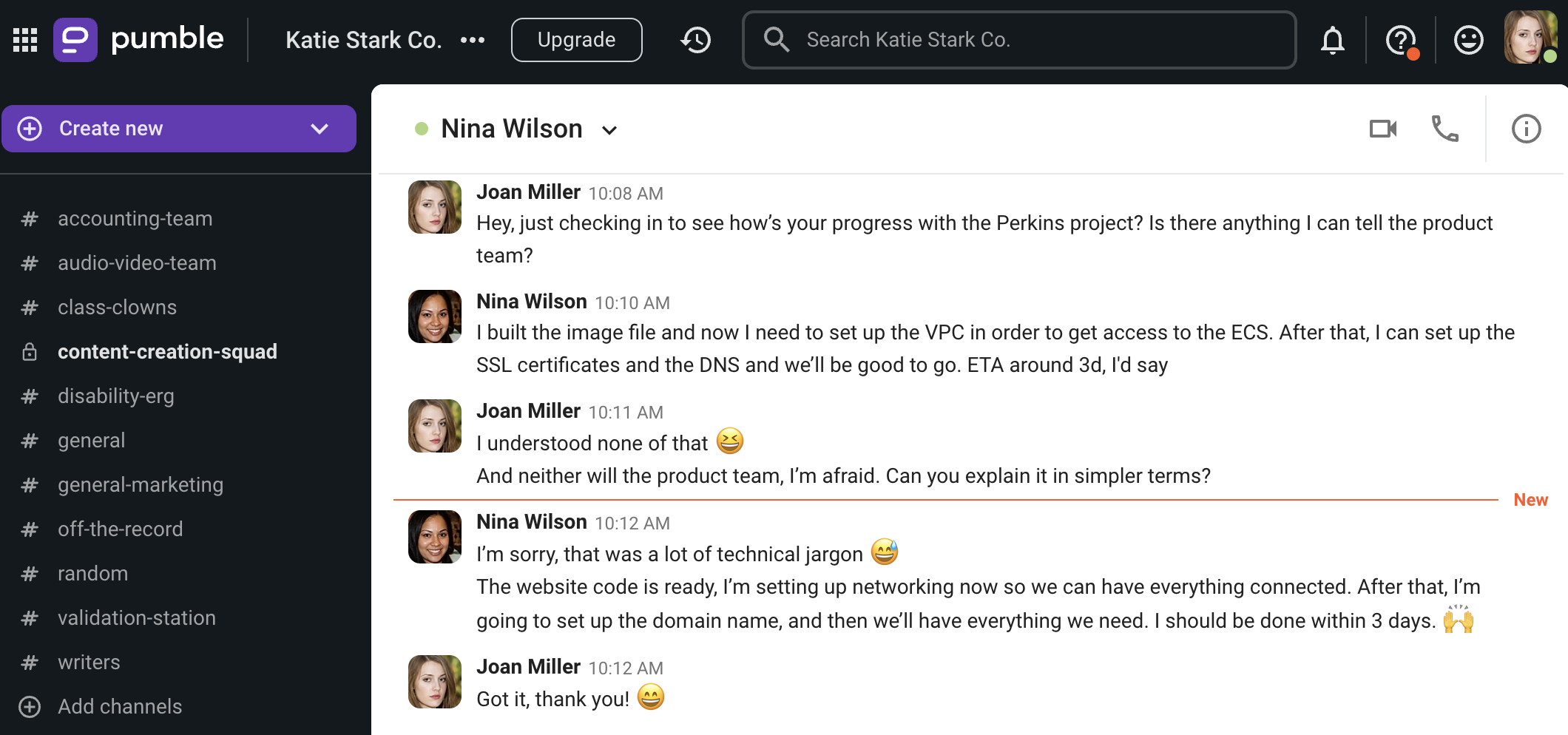
#8 Not following meeting etiquette
Not following meeting etiquette might not seem like a bad communication habit, but it can severely impact your relationships in the workplace.
There are 4 different ways people demonstrate bad communication habits during meetings:
- Wasting time in meetings due to a lack of a meeting agenda,
- Inviting people to meetings who shouldn’t be there,
- Multitasking or being on their phone during a meeting, and
- Unnecessarily filling meeting time.
All these behaviors are excellent examples of poor communication skills because they make you look either disengaged and uninterested or wasteful and inattentive of other people’s time.
How to break the habit of not following meeting etiquette
Meeting etiquette might seem convoluted to those just starting out in their work fields. However, it’s something you definitely need to learn to survive in the corporate world (or at least maintain your relationships with your teammates).
As Kelly McDonald, Author, Speaker, and Business Leader, suggested, try to use common sense — for example, don’t invite people to meetings unless they really need to participate in them.
Similarly to that, don’t waste or fill time in meetings just for the sake of it:

“Don’t feel compelled to chit-chat to fill the extra time. Be respectful and conclude the meeting when the business is finished – your coworkers will love you for it. A simple, ‘Well, we tackled this in less time than I thought. Thanks, everyone – have a good rest of your day.’ will do. That’s what top executives do.”
💡 Pumble Pro Tip
If you need an extra hand when it comes to how to conduct meetings in the workplace (especially virtual ones), read these blog posts:
Pumble: Your biggest ally in breaking bad communication habits
To completely eradicate bad communication habits, you can work on your self-awareness and listening skills. However, you also have to utilize the right communication tools.
An all-in-one team communication app, Pumble can help you stay on top of your bad habits and become an excellent communicator.
By including Pumble in your arsenal of tools, you can improve team communication and thus increase your collaboration and overall organizational success thanks to features like:
- Channels — Ensure there’s a proper place for each discussion so everyone can get on the same page;
- Threads — Streamline communication into neat threads and provide a space for everyone to be heard;
- Voice and video messages — Relay important information that you don’t want to send over a written message;
- Video conferencing — Ensure face-to-face time with everyone, no matter their work location and/or time zone;
- Reactions and emojis — Validate everyone’s thoughts and opinions quickly and effortlessly.
Break the chains of bad communication habits!







